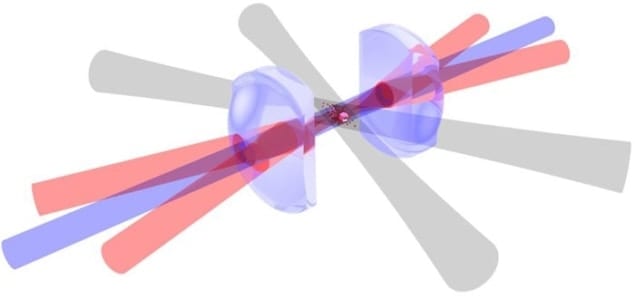
Physicists in the UK have come up with a new way of storing a handful of photons in an ultracold atomic gas, in which strong interactions between neighbouring photons can be switched on and off using microwaves. The team believes that the technique could be used to create optical logic gates in which single photons could be processed one at a time. The method could also prove useful for connecting quantum-computing devices based on different technologies.
Optical photons make very good “flying” quantum bits (qubits) because they can travel hundreds of kilometres through fibres without losing their quantum information. However, it is very difficult to get such photons to interact either with each other or with “stationary” qubits such as those based on trapped ions or tiny pieces of superconductor. Exchanging quantum information between such devices can therefore be tricky.
What Charles Adams and colleagues at Durham University have now done is come up with a way of storing individual optical photons in highly excited states of an atomic gas. Once stored, the photons can be made to interact strongly, before being released again. An important feature of the technique is that it uses microwaves, which are also used to control some types of stationary qubit.
Rydberg polaritons
The Durham experiment involves holding up to 100 rubidium atoms in an optical trap created at the focus of a laser beam, before two pulses of light are fired at the trapped atoms. One pulse is “signal” light that is to be stored and the other is “control” light. The control light allows 10 or so neighbouring rubidium atoms to absorb a signal photon, creating a collective state called a “Rydberg polariton”. Such a state is similar to that of a Rydberg atom, which has an electron in a highly excited state – in this case, with a principal quantum number of 60.
When the control pulse is switched off, the photon remains “stored” in a Rydberg polariton for as long as 1 μs. But if the control light is switched on again, the Rydberg polariton is converted back into light, re-emitting the photon that it had held.
Adams told physicsworld.com that the team used Rydberg polaritons – rather than Rydberg atoms – because there is strong coupling between a photon and a Rydberg polariton. This is because the polariton contains many atoms rather than just one. It is therefore much more likely that the photon will be captured and stored in their set-up. Another benefit of a Rydberg polariton is that it will only absorb one photon – and no more.
Micro-spheres in a row
Each Rydberg polariton can be thought of as a 7 μm diameter sphere. The atomic cloud, meanwhile, is only about 30 μm long and has a diameter of about 6 μm – which means that it contains a line of about three Rydberg polaritons in a row. In practice, however, not all of these polaritons will contain a photon, and photons are able to hop between the polaritons. Adams explains that in this case, photons can be lost and are therefore not recovered when the control pulse is switched on again.
However, if a microwave signal is applied to the cloud it creates an interaction between neighbouring polaritons that prevents hopping from occurring – and therefore photons are not lost but rather are recovered when the control pulse is switched back on.
Next step, logic gates
The team believes that this ability to control interactions between adjacent polaritons could be used to create logic gates for single photons. Instead of making three polaritons in a row, this could involve making a Y-shaped junction in which the output of one polariton would be determined by the presence of absence of photons in the other two polaritons.
According to Adams, this would require a new experimental set-up with two focused laser beams and a larger atom cloud – something that the team is looking at creating.
Alex Kuzmich of the Georgia Institute of Technology in the US says that the Durham team’s ability to create strong interactions between single photons makes the work “an important advance”. He adds that the research “breaks new ground on the way towards realization of quantum logic for photons”.
The experiment will be described in an upcoming issue of Physical Review Letters and a preprint is available on arXiv.



